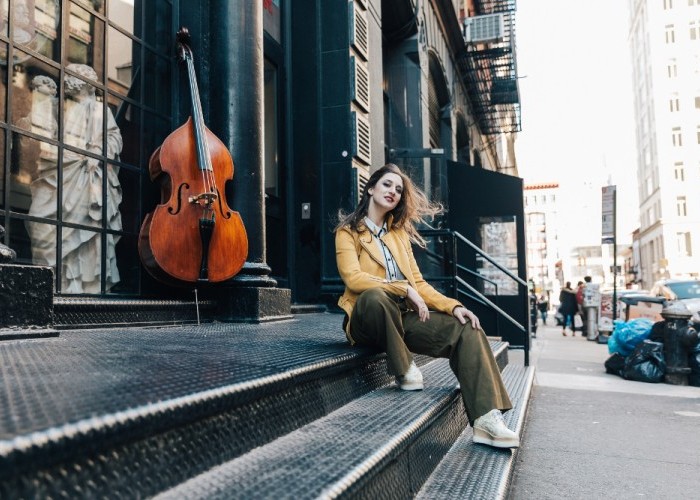Oct 28, 2025 10:47 AM
In Memoriam: Jack DeJohnette, 1942–2025
Jack DeJohnette, a bold and resourceful drummer and NEA Jazz Master who forged a unique vocabulary on the kit over his…

Bassist Adi Meyerson’s leader debut is titled Where We Stand.
(Photo: David Everly)Adi Meyerson not only hears music, she also sees it. “I have this thing called synesthesia,” the bassist said during a recent interview at Jazz at Lincoln Center, explaining that her brain is wired to link sound with colors, letters and numbers. A synesthete’s approach to music certainly isn’t typical, but then again, Meyerson is no ordinary musician. Intuitive and perspicacious, she displays a musical maturity that belies her newcomer status.
Meyerson released her debut, Where We Stand (A:M Records), in June, four years after graduating from a joint program between The Israel Conservatory of Music in Tel Aviv and The New School for Jazz and Contemporary Music in New York. Listening to the album, it’s hard to believe that Meyerson had only been playing upright for eight months when she auditioned for the program; she’d developed her chops playing rock and fusion on electric bass during high school. But at her audition the Israeli pianist/educator Amit Golan (1964–2010), founder of the Center for Jazz Studies at the Israel Conservatory of Music, saw something in the young player and brought her into the program, even with her limited acoustic experience. He then urged her to move in that direction. “I owe him my career in jazz,” Meyerson said. “He didn’t give up [despite] the fact that I wasn’t very good.”
Regardless of her starting point, there’s no denying Meyerson’s authoritative command of her instrument today. Since she moved to New York in 2012, she’s played some of the city’s best venues—Dizzy’s Club Coca-Cola, Smalls, Smoke and, for her album release, Jazz Standard—and she’s shared the bandstand with established luminaries as diverse as drummer Charli Persip, singer-pianist Champion Fulton and saxophonist Joel Frahm, who contributes to Where We Stand.
In addition to Meyerson’s work as an accompanist, she leads a quintet that focuses on her original compositions.
“I remember when she first showed up on the New York jazz scene,” said Frahm in a phone call after a concert at the Vitoria-Gasteiz Jazz Festival in Spain this summer. “[I was] impressed by her presence, because the acoustic bass is such a challenging instrument. It’s rare to see young people who have so much poise.”
Where We Stand is a collection of nine originals that reflect Meyerson’s five years of personal and musical development upon moving to New York. The earliest composition on the recording, “Little Firefly,” features Frahm on a skittering, artful solo and guitarist/vocalist Camila Meza singing Meyerson’s enticing melody and pensive lyrics; the tune evokes clear, yet shifting, visual images. In contrast, the album’s title track is more abstract and harmonically complex. “I wrote it [only] a month before the session and had a question mark on it when we went into the studio,” Meyerson said. “But I took the first take and it became the title track.”
Meyerson recruited an all-star cast for the album. In addition to Frahm and Meza, the ensemble included trumpeter Freddie Hendrix, pianist Matt King and drummer Kush Abadey.
While Meyerson hesitated to delineate a clear evolution in her composing, she explained that over the past few years, her work has become deeper, more meaningful. Of late, she’s been trying to stretch herself, experimenting with open forms and unpredictable melodies. Artistically, it’s an ongoing process. “I’m still learning how to play my own music. … It [takes] a lot of listening back and realizing that this doesn’t work or that this sounds good. It took me a long time to be able to say that and believe it,” she admitted.
As a bandleader, though, Meyerson displays no hint of doubt about what she wants from her music or her collaborators. “She has a really strong idea of who she wants to be as a musician and is committed to that direction,” Frahm observed.
So, what’s on the horizon for Meyerson? On her to-do list is a strings project that is less about jazz, maybe with electric bass. She’ll continue to work with her quintet, and perhaps they’ll record a standards album. She also wants to do a bassist tribute project, where she performs lesser-known tunes by other composer-bassists.
Most intriguingly, she’s thinking about composing a suite inspired by the work of sculptor and multidisciplinary artist Yayoi Kusama, whose intense, variegated art triggers sonic explosions in Meyerson’s brain: “Her colors are like … sound everywhere.” DB

Jack DeJohnette boasted a musical resume that was as long as it was fearsome.
Oct 28, 2025 10:47 AM
Jack DeJohnette, a bold and resourceful drummer and NEA Jazz Master who forged a unique vocabulary on the kit over his…

Always a sharp dresser, Farnsworth wears a pocket square given to him by trumpeter Art Farmer. “You need to look good if you want to hang around me,” Farmer told him.
Sep 23, 2025 11:12 AM
When he was 12 years old, the hard-swinging veteran drummer Joe Farnsworth had a fateful encounter with his idol Max…

D’Angelo achieved commercial and critical success experimenting with a fusion of jazz, funk, soul, R&B and hip-hop.
Oct 14, 2025 1:47 PM
D’Angelo, a Grammy-winning R&B and neo-soul singer, guitarist and pianist who exerted a profound influence on 21st…

Kandace Springs channeled Shirley Horn’s deliberate phrasing and sublime self-accompaniment during her set at this year’s Pittsburgh International Jazz Festival.
Sep 30, 2025 12:28 PM
Janis Burley, the Pittsburgh International Jazz Festival’s founder and artistic director, did not, as might be…

Jim McNeely’s singular body of work had a profound and lasting influence on many of today’s top jazz composers in the U.S. and in Europe.
Oct 7, 2025 3:40 PM
Pianist Jim McNeely, one of the most distinguished large ensemble jazz composers of his generation, died Sept. 26 at…